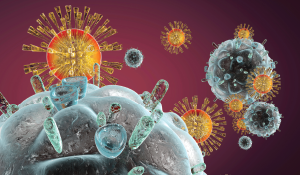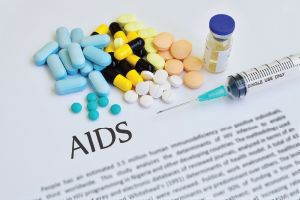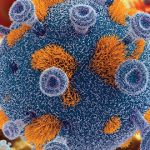Rheumatologists treating HIV patients in 2017 must think through many important factors as this population ages. As we continue to learn, rheumatologists must consider important drug–drug interactions, relatively uncommon rheumatological presentations of HIV, as well as specific diagnostic challenges. Working closely with infectious disease specialists is the best way to achieve optimum care for this patient group.
Rheumatic Issues & HIV: Background
Relatively soon after the onset of this human immunodeficiency virus (HIV) epidemic in the 1980s, clinicians and researchers began describing a number of different rheumatic problems associated with the disease. Very early on, researchers described such symptoms as reactive arthritis.1 They found that HIV patients suffered from a dramatic immunodeficiency, leaving them susceptible to a variety of opportunistic infections, some of which had symptoms that required treatment input by rheumatologists.2
Researchers eventually learned that initial infection with HIV is sometimes accompanied by myalgias, arthralgias and other symptoms, although it is often not diagnosed at the time. Moreover, it became evident that a wide variety of rheumatic problems occurred in many patients with active HIV, among them general myopathy and arthropathy, infectious arthritis, inflammatory myopathies, vasculitis, rheumatoid arthritis, seronegative spondyloarthritidies, psoriatic arthritis and avascular necrosis. Although rheumatic manifestations of HIV are thought to be possible at all stages of HIV infection, many appear to be most common in the advanced, untreated stages of the disease.1,3-7
Rheumatology Care for HIV-Positive Patients After cART
The prognosis for patients with HIV changed dramatically with the introduction of combination antiretroviral therapy or cART (previously known as highly active antiretroviral therapy or HAART). These therapies, first introduced in the late 1990s, began to usher in a new era of improved HIV prognosis.2 Clinicians began to use these drugs in specific combinations to keep viral loads of HIV extremely low and CD4+ immune cells levels high, thus preventing opportunistic infections.2
Since the introduction of these new treatments, mortality from HIV has decreased dramatically.2 In areas of the world where such treatments are readily available, unmanageable opportunistic infections from HIV are uncommon. HIV has morphed from a universally untreatable and fatal illness into a manageable chronic illness. It is, however, one that poses continued health challenges, including metabolic changes, cardiovascular disease and liver problems.8 As of 2013, people aged 55 and older made up more than a quarter of the estimated 1.2 million people living with HIV infection in the US.9
All of this has dramatic implications for the rheumatologist caring for patients who are HIV positive. Rheumatologists in the U.S. now see far fewer patients who are dealing with severe, direct rheumatic consequences of uncontrolled HIV.
Leonard H. Calbrese, DO, FACR, is a professor of medicine at the Cleveland Clinic Lerner College of Medicine of Case Western Reserve University in Cleveland, Ohio. He has extensive experience treating HIV-positive patients as a rheumatologist. “Rheumatologists need to keep this on their radar screen, because there is an aging HIV population that will need care for rheumatic problems that may be totally unrelated to HIV infection, but they have underlying HIV, and that is quite an important co-morbidity,” he explains. “The rheumatic complications of HIV infection itself are decreasing; these are relatively rare complications, but the aging HIV population with gout or osteoarthritis or back pain—these are important.”
A Complex Picture
For practicing rheumatologists, the picture remains complex. We have a relatively poor understanding of the prevalence of various rheumatic conditions in HIV. Epidemiological studies of rheumatic symptoms in the cART era have reported widely different numbers, as recently reviewed.3,4 For example, Hochberg and colleagues concluded that reactive arthritis was not more common in people with HIV, unlike previously believed.10 Others have concluded that musculoskeletal symptoms remain common in these patients.11 We lack good data on the true prevalence of many of these syndromes, and this prevalence may be quite different in areas where many patients are not well controlled with cART therapies.
Another reason for complexity is the variety of causes of rheumatic symptoms in HIV-positive persons. Many patients have unrelated rheumatic symptoms that need treatment, but others have symptoms from syndromes triggered by HIV. These may be caused by the illness itself, or secondarily through medication side effects, such as myopathy from zidovudine.12 Some patients with HIV are also at risk of rheumatic syndromes due to infection with other sexually borne illnesses, such as a reactive arthritis resulting from Chlamydia infection. Additionally, a patient with advanced, uncontrolled HIV may present with rheumatic symptoms from an opportunistic infection, or a person with initial seroconversion may show musculoskeletal symptoms.4
Other types of issues can cause rheumatologic issues in these patients. Karen Walker-Bone, BM, FRCP, PhD, Hon FFOM, is an associate professor in occupational rheumatology at the University of Southampton in Southampton, England. She co-authored an article reviewing management of musculoskeletal disorders in people living with HIV. She recommends also keeping in mind other causes of pain more common in people with HIV, such as peripheral neuropathy and opportunistic malignancies.
Much of the pathophysiology between HIV infection and rheumatic syndromes is not well understood. Sometimes, HIV may transiently improve a rheumatic syndrome, or it may make it worse, depending on context.1,3-7
HIV may increase the risk of certain rheumatic conditions in HIV patients through several mechanisms. Researchers have found the HIV p24 antigen and HIV DNA in the synovial fluid of specific joints affected in individuals with HIV-associated arthropathy.13 Related viruses are known to cause arthritis in animals and humans.4 HIV also causes dysregulation of the immune system that can facilitate autoimmunity.14 The virus causes not only immunodeficiency, but also sometimes other transient serum abnormalities, such as positive IgG rheumatoid factor and anti-CCP antibodies.15
Complexities in Diagnosis
Whether HIV itself is best thought of causing these conditions or simply increasing their likelihood, it can lead to challenges in diagnosis. For example, rheumatoid arthritis can appear quite similar to HIV-associated arthritis, but mistaking one for the other can lead to problems for patients.16
Adewale O. Adebajo, MBBS, MSc, is a professor of rheumatology and health service research at the University of Sheffield in Sheffield, England. He is also one of the authors of a recent review providing a practical guide for managing inflammatory arthritis in HIV-positive patients.

Dr. Adebajo
Dr. Adebajo explains, “One of the key issues is that patients who are HIV positive can develop arthritis from HIV that can mimic or disguise rheumatoid arthritis.” He argues for thoughtfulness in giving a diagnosis of rheumatoid arthritis to such HIV-positive patients. “There are various serological indications including ESR and rheumatoid factor and so on, but you need to be cautious in interpreting markers in these patients. I would advocate retesting in those patients at least six months down the line.”
Diagnosing these patients incorrectly can have implications for their treatment. “In general, in patients who have HIV-related arthritis, we would initially start with a non-steroidal anti-inflammatory drug and then see how they respond. But we stopped doing that with RA many years ago. Now, once we make a diagnosis of rheumatoid arthritis, we immediately put them on disease-modifying drug, usually methotrexate.”
Monitoring may also be more challenging in patients who have both rheumatoid arthritis and HIV. Dr. Adebajo recommends being aware that such factors as the sedimentation rate are often consistently elevated in patients with HIV, so rheumatologists must use other clinical measures to assess disease status. (Carroll and colleagues recently reviewed more specifics on the management of RA in patients with HIV.)16
HIV-Specific Rheumatic Syndromes

The human immunodeficiency virus in the blood stream.
Spectral-Design/shutterstock.com
For rheumatologists practicing in the U.S., it is worthwhile being aware of HIV-specific rheumatic syndromes, even though they seem to be occurring less frequently since the availability of cART treatments.
HIV-associated arthritis: HIV-associated arthritis epitomizes some of the central questions and challenges that surround the treatment of rheumatic symptoms in patients with HIV. Currently, researchers are actively debating whether HIV-arthritis should be regarded as a distinct clinical entity or whether it is simply a coincidental finding in patients who are HIV positive.1
It has been categorized as an acute arthritis that presents as an asymmetric oligo arthritis, symmetrical polyarthritis or a monoarthritis. The symmetrical polyarthritis form closely resembles rheumatoid arthritis. The asymmetric, oligo variation may be the more common form, affecting primarily the knees and ankles. It is a short-lived syndrome peaking in intensity in one to six weeks. Antinuclear antibody, rheumatoid factor and HLA-B27 are all negative, and there are no other classical features that would group them in with another recognized inflammatory arthropathy.1,4
Painful-articular syndrome: This is an extremely painful, but very short-lived syndrome without synovitis or signs of inflammation. It is described as usually affecting the knees, shoulders or elbows, although smaller joints can also be affected. Case studies have reported incidences as high as 10% in patients with late-stage HIV, but other studies have not reported any cases. The syndrome continues to be reported in the cART era. Some researchers speculate that the syndrome may be a feature of specific populations or conditions that are not currently known, such as HIV contracted through intravenous drug use.1,4
DILS: The rare disorder diffuse infiltrative lymphocytosis syndrome (DILS) is similar to Sicca syndrome, but is associated with HIV infection. The condition causes salivary gland swelling, chronic sicca symptoms and sometimes extraglandular manifestations. These patients are negative for anti-Ro/SSA and anti-La/SSB, with CD8+ infiltration of glandular tissue. It was commonly reported in the pre-cART era, but it may now currently be underdiagnosed. Effective cART often improves symptoms, but DILS may relapse even with adequate therapy.4,17

Dr. Calabrese
IRIS: Immune reconstitution inflammation syndrome (IRIS) is an important phenomenon to consider after initiation of cART therapy. It is an overwhelming inflammatory response linked to rapidly recovering immune systems. In HIV, it seems to be linked to increases in CD4+ T-helper and CD8+ T-suppressor cells. Paradoxically, certain immune and autoimmune conditions can worsen after therapy begins, including sarcoidosis, lupus, myositis and rheumatoid arthritis.18 Symptoms may begin days to months after therapy begins. Most of these cases resolve spontaneously, but at times they can become life-threatening in severity, necessitating other interventions. Usually, it is not necessary to stop antiretroviral therapy during this time.18 Dr. Calabrese notes that just being aware of the condition helps clinicians, since IRIS is usually self-limiting and should not need lifelong therapy.
Many patients have unrelated rheumatic symptoms that need treatment, but others have symptoms from syndromes triggered by HIV. These may be caused by the illness itself, or secondarily through medication side effects, such as myopathy from zidovudine.
Rheumatic Conditions with Specific Characteristics in HIV-Positive Patients
Additionally, vast arrays of rheumatic conditions may have specific characteristics in the HIV-positive person and may occur with higher frequencies in certain HIV-positive populations. These include spondyloarthropathies, reactive arthritis, myositis, psoriatic arthritis, rheumatoid arthritis and systemic syndromes, such as lupus and vasculitis. These have been extensively reviewed.1,3-7
One condition that deserves special attention is avascular necrosis. Unlike many other rheumatic complications of HIV, its incidence seems to be rising. People positive for HIV have roughly 10 times the rate of avascular necrosis compared with the general population.19 It is unclear whether this increased risk is due to HIV itself or due to a side effect of cART treatment. Because this condition may require urgent medical treatment, clinicians must maintain a high index of suspicion for avascular necrosis when investigating HIV-positive patients who have joint pain.20
Osteoporosis is another condition that deserves particular attention in the cART era. Although the etiology is not completely clear, patients who are HIV positive are at higher risk of bone fragility and bone fracture.21 Therapy with cART may actually reduce bone density in the short term, although this may decrease with time.19 Patients at particularly high risk of osteoporosis may need to undergo increased monitoring. They may also need to avoid specific HIV medications that increase osteoporosis risk, such as tenofovir and medication regimens based on protease inhibitors.21
Rheumatoid arthritis can appear quite similar to HIV-associated arthritis, but mistaking one for the other can lead to problems for patients.
Specific Drug Interaction Concerns
Drug interactions are an area of key concern for rheumatologists treating HIV-positive patients, because antiretroviral therapies are among the types of drugs most likely to cause interactions.22 Around 40 drugs are currently approved by the FDA to treat HIV, and new drugs continue to be added. These include drugs in a number of different classes, including nucleoside/nucleotide reverse transcriptase inhibitors (NRTIs), non-nucleoside reverse transcriptase inhibitors (NNRTIs), entry inhibitors, integrase inhibitors, protease inhibitors (PIs), booster drugs and combination products. This makes it difficult even for specialists to be aware of all possible interactions.23,24

Glucocorticoid levels may be extremely variable when used with the drugs that treat HIV, leading to the risk of Cushing syndrome.
Jarun Ontakrai/shutterstock.com
One of the most important areas for concern is the potential for interaction between glucocorticoids and HIV drugs, specifically, protease inhibitors. These drugs include darunavir, lopinavir, saquinavir and ritonavir.23 These drugs have large effects on the cytochrome P450 enzyme system in the liver, specifically the enzyme CYP3A4. Because many glucocorticoids use this system as their major method of metabolism, glucocorticoid levels may become extremely variable when used with these HIV drugs, leading to the danger of Cushing syndrome.4
Dr. Calabrese points out, “Something as simple as a methylprednisolone dose pack can be cataclysmic if patients are on a drug such as ritonavir, which can increase the biologic effect of these drugs by 300 or 400%.” Because of its low threshold for toxicity, colchicine for gout is another treatment that must be used cautiously in combination with protease inhibitors and other HIV drugs that utilize the P450 system.25
Although non-steroidal anti-inflammatory drugs are generally safe, it is still worth checking for interactions, because so many complex drugs are used in HIV. When in doubt, get help from infectious disease specialists, pharmacists or other resources. The members of the Department of Pharmacology at the University of Liverpool maintain a freely available drug–drug interaction resource that can be used to help safely prescribe drugs to HIV-positive patients.22
What Drugs Can Be Used Safely for Rheumatic Conditions in Patients Who Have HIV?
Many rheumatic conditions in patients with HIV can be managed with non-steroidal anti-inflammatory drugs or other therapies that are generally safe in these patients. However, a small proportion of patients receiving cART will also need disease-modifying drugs or biologics to control their disease.
Although published evidence is limited, it appears that these therapies can generally be safely prescribed if testing reveals that that CD4+ counts are above 200 cells/mm3 and the HIV viral activity is completely suppressed.4 Dr. Calabrese notes, “Certain drugs like hydroxychloroquine and sulfasalazine we feel pretty safe about, but antimetabolites like methotrexate or luflonomide or biologic drugs—this is serious business and people need to do this with interprofessional collaboration. Any immunosuppressive in an HIV-infected patient has to be done with active collaboration of the HIV-treating physician under all circumstances.” He adds, “A patient who is not well controlled for HIV will not be a good candidate for many therapies.”
This is an area of ongoing research. Dr. Calabrese is a co-author of recently published study examining the biologic drug TNF-α for refractory rheumatoid arthritis in patients who are also HIV positive. When carefully selected and monitored, these patients do not appear at greater risk of infection compared to patients without HIV.26
Key Points for Rheumatologists
1) Maintain a low threshold for HIV testing in the rheumatology office. Currently in the U.S., there are no specific recommendations on testing for HIV in the context of rheumatic care. However, the general public health recommendation is that healthcare providers should test everyone between the ages of 13 and 64 at least once for HIV, with repeated screenings recommended for persons at high risk of HIV. Patients should be informed so they can opt out if they wish, but pretest counseling is not necessary.27
Dr. Calabrese points out, “This is not observed by most physicians, even primary care physicians. When we are starting immunosuppressive therapy and particularly biologics, we routinely screen people for hepatitis B and hepatitis C. It is very simple to [add HIV]. Ask, ‘Have you ever been tested for HIV infection? We should do this at this time if it makes sense.’”
Such testing is critical if other signs in the clinical history point to the possibility of HIV. Of the roughly 1.2 million people living in the U.S. with HIV, approximately 13% do not know they are infected.28
2) Collaborate early and often with infectious disease specialists. Especially be aware of potential drug–drug interactions with HIV medications. Notes Dr. Calabrese, “The most important thing to recognize is that the anti-viral therapy for HIV infection is very complex and that any rheumatic disease that will require specific therapy—even if we recommend a short course of glucocorticoids—has to be viewed through the lens of potential drug–drug interactions with the HIV medications.” This is especially important for disease-modifying anti-rheumatic drugs and immunosuppressives, but it is important to at least check for interactions with any medication.
3) When performing a differential for an HIV-positive rheumatology patient, carefully consider the specific context. Dr. Calabrese advises, “The first thing I do is ask, ‘What is the severity and activity of their HIV infection?’ If it is someone who has been well controlled and they have undetectable virus levels for five years, then my consideration is that they probably just have a rheumatic disease that is totally unrelated to HIV. On the other extreme, if this is poorly controlled, early-onset, active HIV infection and they’re immunodepleted, then the differential expands dramatically. Is this an opportunistic infection, is this a weird inflammatory manifestation of HIV infection, or is the case somewhere in between?”

Dr. Walker-Bone
Dr. Walker-Bone also recommends considering the timing of new rheumatologic symptoms with respect to diagnosis, treatment changes, etc.
4) Be measured when diagnosing new rheumatic syndromes in patients who are HIV positive, especially in the absence of a convincing clinical picture. Realize that they may have transiently positive clinical markers, as well as markers that remain elevated, simply as a component of their HIV. In this context, keep IRIS in mind as a possibility in patients who have recently begun HIV therapy.
5) Be aware of the spectrum of HIV-associated rheumatic diagnostic possibilities. Be especially alert to the possibility of avascular necrosis.
Clinicians must maintain a high index of suspicion for avascular necrosis when investigating HIV-positive patients who have joint pain.
Moving Forward
The intersection of rheumatic disease and HIV illness is still a young area worthy of further study. Ultimately, more research will be needed to discover the optimal treatments for these patients and to uncover the pathophysiological connections between these diseases. Disease registries may help make this possible.
Dr. Adebajo notes, “I would hope that existing rheumatology registries in different countries would be interested in looking at their patients who are HIV positive and collect information about them. In the long term, we need to actually develop registries to look specifically at HIV-positive patients with arthritis.”
Dr. Walker-Bone also suggests, “It would be good to explore the safety and efficacy of some of the more unusual analgesics (e.g., opiates and gabapentinoids) in HIV-infected patients taking cART.”
Currently, around 37 million individuals are living worldwide with HIV.22 As this population ages, more and more patients who are HIV positive will inevitably develop rheumatic disease, and the process of treating HIV will not become less pharmacologically complex any time soon. Rheumatologists will need to become comfortable treating these patients working in tandem with infectious disease doctors and other healthcare providers.
Ruth Jessen Hickman, MD, is a graduate of the Indiana University School of Medicine. She is a freelance medical and science writer living in Bloomington, Ind.
In Brief
Currently, around 37 million individuals are living with HIV worldwide. As this population ages, more and more patients who are HIV positive will inevitably develop rheumatic disease, and the process of treating HIV will not become less pharmacologically complex any time soon. Rheumatologists will need to become comfortable treating these patients working in tandem with infectious disease doctors and other healthcare providers.
References
- Adizie T, Moots RJ, Hodkinson B, et al. Inflammatory arthritis in HIV positive patients: A practical guide. BMC Infect Dis. 2016 Mar 1;16:100.
- Kallings LO. The first postmodern pandemic: 25 years of HIV/AIDS. J Intern Med. 2008 Mar;263(3):218–243.
- Fox C, Walker-Bone K. Evolving spectrum of HIV-associated rheumatic syndromes. Best Pract Res Clin Rheumatol. 2015 Apr;29(2):244–258.
- Walker-Bone K, Doherty E, Sanyal K, Churchill D. Assessment and management of musculoskeletal disorders among patients living with HIV. Rheumatology (Oxford). 2016. pii: kew418.
- Medina F, Pérez-Saleme L, Moreno J. Rheumatic manifestations of human immunodeficiency virus infection. Infect Dis Clin North Am. 2006 Dec;20(4):891–912.
- Yao Q, Frank M, Glynn M, Altman RD. Rheumatic manifestations in HIV-1 infected in-patients and literature review. Clin Exp Rheumatol. 2008 Sep–Oct;26(5):799–806.
- Walker UA, Tyndall A, Daikeler T. Rheumatic conditions in human immunodeficiency virus infection. Rheumatology (Oxford). 2008 Jul;47(7):952–959.
- Cahill S, Valadéz R. Growing older with HIV/AIDS: New public health challenges. Am J Public Health. 2013 Mar;103(3):e7–e15.
- Centers for Disease Control and Prevention. HIV among people age 50 and older.
- Hochberg MC, Fox R, Nelson KE, et al. HIV infection is not associated with Reiter’s syndrome: Data from the Johns Hopkins Multicenter AIDS cohort study. AIDS. 1990 Nov;4(11):1149–1151.
- Lawson E, Sabin C, Perry N, et al. Is HIV painful? An epidemiologic study of the prevalence and risk factors for pain in HIV-infected patients. Clin J Pain. 2014 Oct 17. Doi: 10.1097/AJP.0000000000000162.
- Arnaudo E, Dalakas M, Shanske S, et al. Depletion of muscle mitochondrial DNA in AIDS patients with zidovudine-induced myopathy. Lancet. 1991 Mar 2;337(8740):508–510.
- Mody G, Parke F. Articular manifestations of human immunodeficiency virus infection. Best Pract Res Clin Rheumatol. 2003 Apr;17(2):265–287.
- Virot E, Duclos A, Adelaide L, et al. Autoimmune diseases and HIV infection: A cross-sectional study. Medicine (Baltimore). 2017 Jan;96(4):e5769.
- Du Toit R, Whitelaw D, Taljaard JJ, et al. Lack of specificity of anticyclic citrullinated peptide antibodies in advanced human immunodeficiency virus infection. J Rheumatol. 2011 Jun;38(6):1055–1060.
- Carroll MB, Fields JH, Clerc PG. Rheumatoid arthritis in patients with HIV: Management challenges. Open Access Rheumatol. 2016 Apr 29;8:51–59.
- Ghrenassia E, Martis N, Boyer J, et al. The diffuse infiltrative lymphocytosis syndrome (DILS). A comprehensive review. J Autoimmun. 2015 May;59:19–25.
- Tappuni AR. Immune reconstitution inflammatory syndrome. Adv Dent Res. 2011 Apr;23(1):90–96.
- Gedmintas L, Solomon DH. HIV and its effects on bone: A primer for rheumatologists. Curr Opin Rheumatol. 2012 Sep;24(5):567–575.
- Chokotho L, Harrison WJ, Lubega N, Mkandawire NC. Avascular necrosis of the femoral head in HIV positive patients—an assessment of risk factors and early response to surgical treatment. Malawi Med J. 2013 Jun;25(2):28–32.
- Brown TT, Hoy J, Borderi M, et al. Recommendations for evaluation and management of bone disease in HIV. Clin Infect Dis. 2015 Apr 15;60(8):1242–1251.
- HIV drug interactions. University of Liverpool. Mission Statement.
- U.S. Food and Drug Administration. Antiretroviral drugs used in the treatment of HIV infection.
- Panel on Antiretroviral Guidelines for Adults and Adolescents. Guidelines for the use of antiretroviral agents in HIV-1-infected adults and adolescents. Department of Health and Human Services.
- U.S. Food and Drug Administration. Information for health care professionals: New safety information for colchicine (marketed as Colcrys).
- Wangsiricharoen S, Ligon C, Gedmintas L, et al. Rates of serious infections in HIV-infected patients receiving tumor necrosis factor inhibitor therapy for concomitant autoimmune diseases. Arthritis Care Res (Hoboken). 2017 Mar;69(3):449–452.
- Branson BM, Handsfield HH, Lampe MA, et al. Revised recommendations for HIV testing of adults, adolescents, and pregnant women in health-care settings. MMWR Recomm Rep. 2006 Sep 22;55(RR14):1–17.
- Centers for Disease Control and Prevention. HIV/AIDS. Basic statistics.


